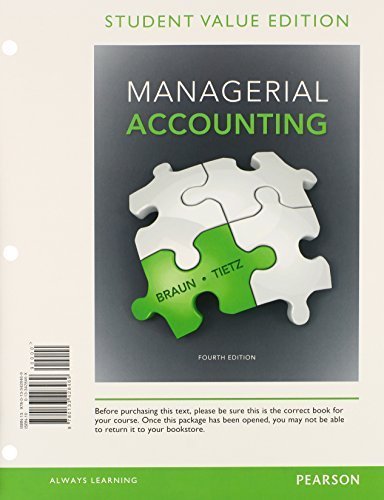
1.
To calculate: Traditional pharmacy
2.
To calculate: Pharmacy overhead to be allocated to order number 1247 using traditional overhead rate.
3.
To calculate: Pharmacy overhead to be allocated to order number 1248 using traditional overhead rate.
4.
To calculate: activity cost pool allocation rates for the given activities.
5.
To calculate: Pharmacy overhead to be allocated to order number 1247 using ABC cost rates.
6.
To calculate: Pharmacy overhead to be allocated to customer order 1248 using ABC cost rates.
7.
To identify: the allocation system that will produce more accurate product cost.
Want to see the full answer?
Check out a sample textbook solution
Chapter 4 Solutions
Managerial Accounting, Student Value Edition Plus New Myaccountinglab With Pearson Etext -- Access Card Package (4th Edition) By Braun, Karen W., Tietz, Wendy M. (2014) Loose Leaf
- Can you please answer the financial accounting question?arrow_forwardidentify the key factors that contributed to the collapse of Northern Rock bank. Compile documents and analysis of regulations (magazine articles, newspapers, online sources, working papers from different organizations, activity summaries, results reports, legal regulations, speeches, public statements, press conferences, etc.). Apply, in a practical and theoretical way, what has been learned in class about the financial world, regulation and risk management.arrow_forwardGet accurate answer this general accounting questionarrow_forward

 AccountingAccountingISBN:9781337272094Author:WARREN, Carl S., Reeve, James M., Duchac, Jonathan E.Publisher:Cengage Learning,
AccountingAccountingISBN:9781337272094Author:WARREN, Carl S., Reeve, James M., Duchac, Jonathan E.Publisher:Cengage Learning, Accounting Information SystemsAccountingISBN:9781337619202Author:Hall, James A.Publisher:Cengage Learning,
Accounting Information SystemsAccountingISBN:9781337619202Author:Hall, James A.Publisher:Cengage Learning, Horngren's Cost Accounting: A Managerial Emphasis...AccountingISBN:9780134475585Author:Srikant M. Datar, Madhav V. RajanPublisher:PEARSON
Horngren's Cost Accounting: A Managerial Emphasis...AccountingISBN:9780134475585Author:Srikant M. Datar, Madhav V. RajanPublisher:PEARSON Intermediate AccountingAccountingISBN:9781259722660Author:J. David Spiceland, Mark W. Nelson, Wayne M ThomasPublisher:McGraw-Hill Education
Intermediate AccountingAccountingISBN:9781259722660Author:J. David Spiceland, Mark W. Nelson, Wayne M ThomasPublisher:McGraw-Hill Education Financial and Managerial AccountingAccountingISBN:9781259726705Author:John J Wild, Ken W. Shaw, Barbara Chiappetta Fundamental Accounting PrinciplesPublisher:McGraw-Hill Education
Financial and Managerial AccountingAccountingISBN:9781259726705Author:John J Wild, Ken W. Shaw, Barbara Chiappetta Fundamental Accounting PrinciplesPublisher:McGraw-Hill Education





